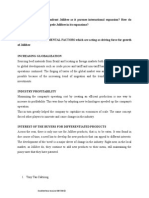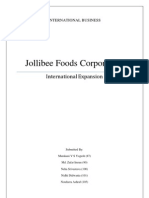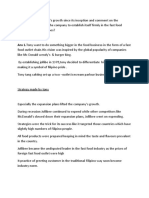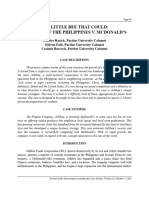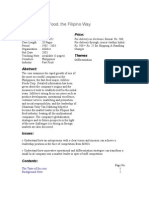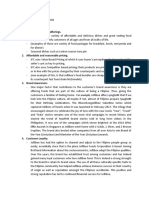Jollibee Foods Corporation: January 2016
Jollibee Foods Corporation: January 2016
Uploaded by
Cookies And CreamCopyright:
Available Formats
Jollibee Foods Corporation: January 2016
Jollibee Foods Corporation: January 2016
Uploaded by
Cookies And CreamOriginal Title
Copyright
Available Formats
Share this document
Did you find this document useful?
Is this content inappropriate?
Copyright:
Available Formats
Jollibee Foods Corporation: January 2016
Jollibee Foods Corporation: January 2016
Uploaded by
Cookies And CreamCopyright:
Available Formats
See discussions, stats, and author profiles for this publication at: https://www.researchgate.
net/publication/301285243
Jollibee Foods Corporation
Chapter · January 2016
CITATIONS READS
0 84,387
3 authors, including:
Jochen Wirtz
National University of Singapore
240 PUBLICATIONS 9,459 CITATIONS
SEE PROFILE
Some of the authors of this publication are also working on these related projects:
Impact of Display of Anger @ the Service Encounter View project
Teaching Resources for Services Marketing & Management View project
All content following this page was uploaded by Jochen Wirtz on 11 March 2019.
The user has requested enhancement of the downloaded file.
C ASE
Jollibee Foods Corporation
Leonardo R. Garcia Jr., Christopher Lovelock, and Jochen Wirtz
A Philippine fast foods company has achieved market dominance in three segments in its home
country — burgers and chicken, pizzas, and Chinese food — beating out such well-known
international competitors as McDonald’s and Pizza Hut. What is the secret to its domestic success
and what are the lessons for its international ventures?
Around the world, when someone says “fast food By September 2004, the total number of stores worldwide
restaurant”, the chances are high that the first name that in the JFC Group had grown to 1,128, of which 1,008
comes to mind will be McDonald’s, the world’s largest were located in the Philippines, and the balance in several
quick-service restaurant chain. In 2004, McDonald’s other countries, led by the recently acquired Yonghe
held a 20% share of the US fast-food market, triple that King chain in China. That year, Jollibee beat 31 other
of its nearest competitor Burger King. This was not the entrepreneurs from around the world to win the 2004
case, however, in the Philippines where, for more than World Entrepreneur of the Year award, sponsored by
two decades, fast food had been synonymous with the Ernst and Young, one of the world’s top accounting firms.
name Jollibee. In the global business arena, Jollibee Foods
Corporation (JFC) was not exactly a household name.
But in its niche, the Philippines, where it controlled four
brands — Jollibee, Delifrance, Greenwich Pizza, and JOLLIBEE: THE EARLY YEARS
Chowking — it dominated the market.
Humble Beginnings
During the 1990s, JFC extended its sights overseas, In 1975, Tony Tan Caktiong, a Filipino of Chinese
opening a small number of restaurants in several Asian ancestry, and his brothers opened two ice cream parlors
and Middle Eastern locations. The company’s chairman in Manila’s commercial districts of Cubao and Quiapo.
and CEO, Tony Tan Caktiong, observed: These ice cream parlors were an instant hit among food-
loving Filipinos, who came to associate the stores with
Internationalization remains a key component
special occasions such as birthdays and holidays. In
of our business strategy, even as we continue to
no time, the Tan brothers had decided to expand their
reinforce our domestic network of stores. Our
menu and began offering other quick meals such as hot
goals of continued growth, profitability and
sandwiches, spaghetti and burgers. After its second year
market leadership, as well as our contribution to
of operations, the Tan brothers noted that the store was
the development of our country, may lie not just
actually earning more from the side orders, specifically
in continuing to expand aggressively at home
their burgers, than from the ice cream.
but also in becoming a truly multinational
Filipino corporation.
Following the taste and feel of the market, the Tan
brothers decided to develop their own unique brand by
© 2005 by Leonardo R. Garcia, Jr., Christopher H. Lovelock, and coming up with a menu that would appeal to the Filipino
Jochen Wirtz. palate. Jollibee was conceived as a fast-food outlet of high-
The authors gratefully acknowledge the assistance of Kristine quality but reasonably-priced food products tailored
Abante. especially for Filipinos, who were served by a jolly,
“busy-as-a-bee” restaurant crew. Hence the birth of the
This case is based on published sources, student research and
personal experience. It was prepared solely for use as a learning bright red and yellow “Jolly Bee” mascot, which had since
tool and is not intended to serve as an endorsement, source of become a favorite among Filipino children. In response
primary data, or illustration of effective or ineffective management. to the growing popularity of their sweet homemade
Financial data in the Philippine pesos (exchange rates in mid-2004 burgers — made from their mother’s secret recipe — and
were PHP1 = US$0.018, or US $1 = PH56). the other hot meals, Tony Tan and his brothers formed
766 Case 20 ▪ Jollibee Foods Corporation
PART 6
Jollibee Foods Corporation (JFC) in 1978 to exploit the like the Ice Craze in Buko pandan (coconut and jelly) and
possibilities of a hamburger concept more fully. By that mais con yelo (sweet corn) served with milk and crushed
time, the firm had seven outlets. ice; traditional Filipino breakfast rice meals, and options
such as the Tuna Pie and Pies-to-Go. Never before had
When McDonald’s entered the Philippine market in Filipinos — children, families, and adults from all walks
1981 and began opening stores in Manila, some industry of life — been offered so much in a single location.
observers questioned whether the little 11-store local
chain could survive. However, Jollibee’s management Addition of New Brands
team decided to see this as an opportunity that would
allow them to benchmark the American giant’s operations By 1989, Jollibee had become the first Philippine fast-
and then bring their own chain up to world-class food chain to break the one billion peso sales mark. In
standards. In particular, they focused on learning 1993, Jollibee Food Corporation (JFC) went public on
about the sophisticated operating systems that enabled the Philippine Stock Exchange to broaden its capital
McDonald’s to control its quality, costs, and service at the base, laying the groundwork for expansion both within
store level — an area of weakness in the local firm that and beyond Philippine shores. Over the years, the size,
had constrained further expansion. As Tony Tan gained geographic expanse and breadth of the company’s
a better understanding of McDonald’s business model, operations had continued to grow. In addition to the
he recognized not only strengths but also specific areas of original chain of Jollibee burger restaurants, several new
weakness in the latter’s strategy, reflecting its standardized brands had been added through acquisition.
product line and a US-dominated decision processes.
Even as the Jollibee brand achieved market dominance,
the firm was also pursuing a strategy of diversification
Capturing Filipinos’ Taste buds as a hedge against both competition and downturns in
In the Philippines, people love to eat and are used to specific market niches. Reaching out to other segments,
doing so up to five times daily, enjoying snacks in between Jollibee Foods Corporation had acquired a portfolio of
meals and a comfortable place to chat with friends other fast-food concepts, to which it applied its carefully
and loved ones. As a result, the nation had become an honed operational and marketing skills. In 1994, it
attractive market for global players such as McDonald’s, purchased Greenwich Pizza, the Philippines’ leading
KFC, Wendy’s, Burger King, and Pizza Hut. Yet, despite pizza and pasta chain. The following year, seeking to cater
growing competition, Jollibee had managed to maintain to the changing taste preferences of the Filipinos, JFC
its dominant position as the leading fast-food chain in acquired the right to operate the Philippine’s franchise of
the Philippines, with a menu tailored specifically to the Délifrance, an international chain of French bakery-cafés
Filipinos’ preferences. headquartered in France. In 2000, JFC bought Chowking
Foods Corporation, the Philippines’ top chain serving
Jollibee’s keen insight and understanding of the Filipino Chinese fast-food.
psyche had brought to everyone’s lips the promise of
langhap-sarap (freely translated, this means “smells good Although Chowking had reported excellent sales and
so it must taste good”). In addition to meals with fries, performance since its purchase, it took time before
Jollibee offered rice or spaghetti with its entrees. Its moist Greenwich Pizza was able to establish a strong position in
burger patties and spicy sauces were so distinctly Filipino the market. By the end of 2003, JFC was the Philippines
that Jollibee’s burgers were often likened to what a Filipino market leader in three segments. In the hamburger and
mother would cook at home. This strong understanding chicken segment, Jollibee had 467 outlets to only 240 for
of Filipino’s taste and preferences set Jollibee apart from its nearest rival, McDonald’s. In Chinese fast-food, there
its competitors. were 245 Chowking restaurants, compared to 136 for its
nearest competitor, Luk Yuen. And finally, JFC’s pizza
Although long-time favorites like Chickenjoy, Spaghetti and pasta outlet, Greenwich, had 213 stores as compared
Special, Jolly Hotdog, French fries and Yumburgers still to 113 for its nearest rival, Pizza Hut.1 Exhibit 1 shows
continued to hold their appeal, over time, Jollibee had trends in the number of stores by brand between the end
broadened the product range to create more excitement of 1998 and September 2004.
and variety. The enlarged menu included more rice-based
products like Honey Beef Rice and Shanghai Rolls; a
variety of burger choices from mushroom to garlic and 1 “Jollibee beats McDonald’s at its own game,” PJI Journal, www.
cheese, a variety of chicken dishes, more flavorful desserts journal.com.ph, accessed January 17, 2005.
Case Studies 767
Exhibit 1 Trends in Number of Stores by Brand, 1998–2004
Year ending Dec. 31
Q3 2004 2003 2002 2001 2000 1999 1998
The Philippines
Jollibee 478 467 436 408 374 350 302
Greenwich 226 213 191 194 193 191 169
Chowking 276 245 216 194 164 159 142
Delifrance 28 30 28 24 13 6 4
Subtotal 1,008 955 871 832 744 712 617
International
Jollibee 23 21 21 23 22 21 n.a.
Chowking 8 9 8 7 6 6 n.a.
Tomi's Teriyaki* – 3 2 1 – – n.a.
Yonghe King 89 – – – – – n.a.
Subtotal 120 33 31 31 28 27 n.a.
TOTAL 1,128 988 902 863 772 739 n.a.
Source
Fourth quarter reports, 1998–2003; 3rd quarter report, 2004.
Exhibit 2 Jollibee Foods Corporation: Selected Annual Financial and Operational Data, 1998–2003
2003 2002 2001 2000 1999 1998
Consolidated System-wide Sales 28.9 26.8 24.1 20.3 18.1 16.7
(billion pesos)
Gross Revenues (billion pesos) 21.6 20.3 18.8 15.7 14.1 12.9
Income from Operations (billion pesos) 1.4 1.5 0.8 1.1 0.9 1.2
Net Income (billion pesos) 1.3 1.0 0.5 0.9 0.6 0.8
Net Income (billion pesos) 21.6 22.0 21.8 20.6 14.2 13.9
Source
Annual Reports, Jollibee Foods Corporation, 1998–2003.
Exhibit 3 Jollibee Food Corporation: Values—Mission—Vision
Values
• Always put customer first
• Excellence through teamwork
• Spirit of family and fun
• Frugality, Honesty and Integrity
• Humility to listen and learn
Mission
We bring great taste and happiness to everyone
Vision
Become the most dominant and best tasting QSR….The most endearing brand that has ever been
We will be within reach of every Filipino…
We will lead in product taste at all times Source
We will provide FSC excellence in every encounter… Happiness in every moment www.jollibee.com.ph, accessed July 2004.
768 Case 20 ▪ Jollibee Foods Corporation
PART 6
By that time, Jollibee had become had become an The company recognized that maintaining high standards
international brand that, as management declared, made required that employees be committed to FSC. Jollibee
Filipinos proud. Forbes, Far Eastern Economic Review, Foods Corporation paid the highest compensation and
and Asian Business had all ranked JFC among Asia’s benefits package in the Philippine fast-food industry. All
top companies. It was recognized as the number one employees underwent comprehensive training programs
food company in Asia by Euromoney, and as the best- based on the underlying standards. In addition, managers
managed company in the Philippines by Asiamoney, and received ongoing training in the latest operations systems
was consistently ranked among Asia’s best employers and in people management skills. Opportunities existed
in the Far Eastern Economic Review’s annual survey. for qualified crew members to pursue a career path into
In 2004, Jollibee Foods Corporation topped the “Asia’s management positions.
Most Admired Company” (AMAC) survey, conducted
by Hong Kong-based Asian Business Magazine. Exhibit Marketing Strategy
2 shows annual financial and operational data for JFC
from 1998 to 2003. Exhibit 3 reproduces the company’s JFC’s marketing philosophy was based on being closer
values, vision, and mission. to Filipino families than its competitors. There was
wide awareness that Jollibee was a local Filipino service
Twenty nine years after Jollibee was founded, Jollibee business establishment that had captured the unique
Foods Corporation controlled about 55% of the quick- Filipino taste, so it appealed to patriotic or “pam-Pinoy”
service restaurant market in the Philippines based on instincts. The chain also appealed to a broad cross-section
“visit shares” and held 70% of the burger-based meals of the population that felt comfortable and very much at
market. One million customers ate at JFC stores daily, home in an environment where the crew talked to them
averaging a per capita spending of about 40 pesos in the local language, unlike other outlets where the crew
(US$0.71). Each day, JFC bought or produced 40,000 spoke in English and where the atmosphere might be
packs of chicken (with eight pieces in each pack), 320,000 perceived by some as projecting an elitist appeal.
pieces of burger, and 44,250 eggs. With more than 1,000
stores across the Philippines, JFC’s four brands enjoyed The Jollibee chain had tailored its marketing strategies
substantial economies of scale, gaining leverage in terms to suit the Filipino culture and lifestyle. “What happens
of retail site selection and operations, procurement, in the normal Filipino family is that weekends are
manufacturing, distribution and marketing at levels reserved especially for children,” notes a Filipino business
unavailable to most industry players. Despite a recent analyst, “and parents try to ask their children where they
economic slowdown in the Philippines and unfavorable want to eat.” Jollibee appealed to children with in-store
business conditions, JFC had continued to deliver same- play activities and a cast of captivating characters. Its
store sales growth. hamburger-headed Champ, complete with boxing gloves,
went head-to-head against McDonald’s Hamburglar.
Industry observers reported that Jollibee’s giant smiling
MARKETING, OPERATIONS AND red and yellow bee (Exhibit 4) and a blond spaghetti-
HUMAN RESOURCES
Jollibee’s ‘FSC’ Commitment
The acronym FSC, described by the company on its
website as “a byword in all of Jollibee,” represented its
commitment to meeting high standards in three key
areas:
Every Food (F) item served to the public must
meet the company’s excellent standards or it
will not be served at all; the Service (S) must be
fast and courteous; and Cleanliness (C) from
sidewalk to kitchen, from uniforms to utensils,
must be maintained at all times.
Exhibit 4 Typical Jollibee Outlet in the Philippines
Case Studies 769
Exhibit 5 Value Proposition of Jollibee versus McDonald’s in the Philippines
Value Proposition
Jollibee McDonald’s
Target Market Families & Children Families & Children
To provide high quality food, fast and friendly To provide outstanding quality, service,
Business Operations
service in a clean and comfortable environment cleanliness and value.
Tailored to the Filipino palate. E.g., peach-mango Standardized Fare.
Menu
pies, meals with spaghetti or rice. E.g., meals with fries.*
• Langhap Sarap Value Meals • Extra Value Meal
• Jolly Kiddie Meal (with premium items and • Happy Meal (with premium items and toys)
toys)
Promotions • Eats for Free purchase rewards program
• Bestsellers Campaign (20% discounts on
various combinations of the popular Langhap
Sarap Value Meals)
No of Stores in the Philippines 472 241
Mode of International Expansion Franchising Franchising
* McDonald’s has since bowed to the pressure of conforming to Filipino taste preferences by introducing menu items such as McSpaghetti
and McDo, a heavily-seasoned burger.
Source
DLSU Student research project, 2004.
haired girl named Hetti (a mascot for Jollibee restaurants) 94% mentioning this attribute, followed by accessibility/
were better known and loved in the Philippines than many outlets (72%) and tastier (66%). However, only
Ronald McDonald. Jollibee endeavored to maintain its 44% of respondents cited “faster” as a desired attribute.
dominance in the children’s segment by promoting its
Jolly Kiddie Meals and offering a choice of Regular Yum, Emotional Attributes. For fast-foods in general, the
Spaghetti Special or Chickenjoy. Having an advertising three most dominant attributes were friendly atmosphere
strategy that was deeply rooted in the traditional values of (76%), family-oriented or pampamilya (74%), and hang
family, with a tinge of national pride, allowed Jollibee to out or tambayan (66%). The other emotional attributes
position itself as the destination outlet for family outings. considered by respondents were mass appeal, better
environment for kids, patriotic or pam-Pinoy or lasang
The DLSU Survey Pinoy, “brings you closer to home,” “likeable Filipino
selections” or putaheng Pinoy/sangkap Pinoy, “use of
A survey conducted by advertising management students Filipino language” particularly by the service crew, and
from De La Salle University in Manila contrasted the use of “wholesome” or “cute” endorsers (Exhibit 7).
Jollibee’s value proposition against that of McDonald’s Broadly similar ratings of these attributes were achieved
operations in the Phillipines (Exhibit 5) and revealed the for Jollibees, although “family-oriented” was ranked first,
main rational and emotional factors that drove Filipino and “friendly” second.
consumers’ choices in fast food restaurants.
Rational Attributes. Of the top 10 rational attributes Organizational Structure
underlying selection of a fast-food restaurant, the most By concentrating on a country market with distinct
significant, cited by 90% of respondents, was for it to be preferences, Jollibee had been able to tailor its menu
“affordable and/or cheap” (Exhibit 6). Next came “faster and marketing strategies to better reach and satisfy the
service” (cited by 78%), followed by “accessibility” (70%). customers. While global players like McDonald’s and
Other attributes mentioned were “tasty”, “variety of KFC chose to spread their resources among their fast-
food”, “accommodating personnel”, “delivery services”, food chains worldwide, for many years, Jollibee focused
“promotional items are useful”, “frequent and effective its efforts only in the Philippines. During the 1980s, when
ads”, and “offers seasonal products”. Among Jollibee’s political instability hit the Philippines, McDonald’s had to
patrons, affordable/cheaper prices was ranked top, with curtail its expansion process. Jollibee, on the other hand,
770 Case 20 ▪ Jollibee Foods Corporation
PART 6
Exhibit 6 Rational Attributes Filipinos Look for in Fast-Food Restaurants/Jollibee
Fast-Food Market Overall Jollibee
Rank Attribute % Attribute %
1 Affordable/Cheaper 90% Affordable/Cheaper 94%
2 Faster Service 78% Accessibility/Many outlets 72%
3 Accessibility/ “Maraming” (many) outlets 70% Tastier 66%
4 Tastier 68% Frequent and Effective Ads 56%
5 Variety of food chains 60% Variety of food chains 50%
6 Accommodating personnel 34% Faster service 44%
7 Delivery Services 42% Promotional items are useful 40%
8 Promotional items are useful 38% Accommodating personnel 38%
9 Frequent and effective ads 34% Delivery Services 38%
10 Offers seasonal products 28% Offers seasonal products 36%
Total N = 50 100% 100%
Source
DLSU Student research project, 2004.
Exhibit 7 Emotional Attributes Filipinos Look for in Fast-Foods/Jollibee
Fast-Food Market Jollibee
Rank Attribute N % Rank Attribute N %
1 Friendly Atmosphere 38 76% 1 Family togetherness (“Pampamilya”) 39 78%
2 Family togetherness (“Pampamilya”) 37 74% 2 Friendly atmosphere 32 64%
3 Hang-out (“Tambayan”) 33 66% 3 Patriotic, “Pam-Pinoy,” “Lasang 30 60%
Pinoy”
4 Mass Appeal 27 54% 4 Mass Appeal 30 60%
5 Better environment for kids 27 54% 5 Likeable Filipino selections, 28 56%
“Putaheng Pinoy,” “Sangkap Pinoy”
6 Patriotic (“Pam-Pinoy”/”Lasang 22 44% 6 Better environment for kids 28 56%
Pinoy”)
7 Brings you closer to home 17 34% 7 Use of Filipino language 20 40%
8 Likeable Filipino selections 16 32% 8 Wholesome/ “cute” endorsers 13 26%
(“Putaheng Pinoy”/”Sangkap-Pinoy)
9 Use of Filipino language 13 26% 9 Hang-out/ “Tambayan” 12 24%
10 Wholesome/”cute” endorsers 8 16% 10 Brings you closer to home 11 22%
N:50 N:50
Source
DLSU Student research project, 2004.
Case Studies 771
continued with its strategic plans of expansion. By the reaching communities with a large Filipino population to
time the country was back on track, Jollibee had already capitalize on its brand awareness, targeting markets where
gained the upper hand in terms of store locations, thus there were substantial numbers of “OFWs” (Overseas
leaving the global giant trailing behind. Filipino Workers). By the early 1990s, Jollibee restaurants
were operating in Hong Kong, Brunei, Saipan and Guam
The unique geographical structure of the Philippines (both islands in the NW Pacific), Vietnam, Indonesia,
with its many islands made it a challenging market for Dubai, and Kuwait.
fast-food companies. Among all the fast food chains
competing in the Philippines, Jollibee was the only one In 1998, the firm entered one of the most demanding
that operated nationwide. In some locations, it faced no fast-food markets in the world, the US, which had at
competition from other fast-food chains. the time an estimated two million Filipino immigrants.
But aside from Jollibee’s popularity among Filipinos, the
JFC’s strategy included a focus on achieving operational brand also sought to appeal to other ethnic groups in its
efficiency in its commissary and hiring the right US outlets. Other immigrants from Asia came with their
candidates to manage its operations and strategy families in tow to eat at Jollibee’s. One African-American
planning. To meet the challenges of a more intensely customer stated that the chicken is “excellent, almost
competitive market and to manage business more like my mother’s Southern fried chicken!” And white
effectively, the company had undertaken a major initiative Americans enjoyed delicacies not offered by competitors,
in 2000 to re-align the structure of Jollibee Philippines, such as Peach Mango Pie.
decentralizing the organization into four autonomous
Regional Business Units (RBUs) that corresponded to The company’s international expansion strategy focused
the country’s major geographic markets: Mega Manila, on markets where management believed it “could
Luzon, South Luzon, and Visayas-Mindanao. This successfully develop the Jollibee brand and put up the
structure ensured a more manageable business size supply chain to support the critical mass of stores in these
and span of control. Key support functions like human selected markets.” In the US, the first state targeted was
resources and administration, finance and network California, with plans to expand into Nevada, Hawaii,
development were transferred to the RBUs for greater and New York in future years. By adopting a franchise
efficiency in the delivery of products and services, quicker mode in the US, JFC was able to draw on local capital
coordination, and more timely decision-making. and entrepreneurial drive. In 2001, the firm purchased
a majority interest in Tokyo Teriyaki House, a Japanese
The Head Office/Corporate Ser vices functions restaurant in California, with the objective of expanding
(Marketing, Finance, Restaurant Systems, Engineering) into the Japanese QSR segment and developing it into
were re-aligned as a Support Center to provide corporate- another major chain; it renamed the restaurant Tomi’s
level direction and continuing assistance to the RBUs. Top Teriyaki House.
management believed that the new structure had resulted
in better execution of programs and renewed enthusiasm The annual report for 2002 noted that the overseas stores
and commitment from JFC’s managers and employees. were providing the company “the experience in the
The continuing growth in the number of Jollibee, know-how that we need in gearing up to the realities of
Chowking, and Greenwich restaurants obscured the fact international competition and in reorienting ourselves
that each year, some stores were closed, either because to the global environment.”
they were underperforming or because they were being
replaced by newer and larger stores in a better location. JFC had identified several markets in Asia for its
Over time, a higher percentage of stores were being expansion activities. In 2004, the company was looking
operated by franchisees instead of company-owned at the possibility of expanding its three-store network
(Exhibits 8A and 8B). in Vietnam. Plans for introducing the Chowking brand
in Indonesia were also underway, based on the growing
market for Chinese food in that nation. Despite an earlier,
unsuccessful experience operating a now-closed Jollibee’s
INTERNATIONAL OPERATIONS store in Xiamen, eastern China, JFC saw huge potential
in the People’s Republic. In March 2004, the company
Building on its success in the Philippines, Jollibee turned signed an agreement to purchase 85% ownership in
its sights overseas. Initially, the company focused on the Shanghai-based Yonghe King chain, which offered
772 Case 20 ▪ Jollibee Foods Corporation
PART 6
Exhibit 8A Location of JFC Group Stores by Brand, December 31, 2002
Tomi’s
Jollibee Greenwich Chowking Délifrance* TOTAL
Teriyaki**
Philippines
Co-owned 194 110 69 23 – 396
Franchised 242 81 147 5 – 475
Subtotal 436 191 216 28 – 871
Hong Kong 4 – – – – 4
USA 8 – 5 – 2 15
Dubai – – 3 – – 3
Others 9 – – – – 9
TOTAL 1,128 988 902 863 772 739
* JFC was a master franchisee for Délifrance, a French-owned franchise, in the Philippines but not in other countries.
** Initially known as Tokyo Teriyaki House.
Exhibit 8B Location of JFC Group Stores by Brand, September 30, 2004
Jollibee Greenwich Chowking Délifrance* Yonghe King TOTAL
Philippines
Co-owned 190 119 82 23 – 414
Franchised 288 107 194 5 – 594
Subtotal 478 226 276 28 – 1,008
Hong Kong 2 – – – – 2
USA 9 – 8 – – 17
China
Co-owned – – – – 84 84
Franchised – – – – 5 5
Other 12 – – – – 12
TOTAL 501 226 254 30 89 1,128
* JFC was a master franchisee for Délifrance, a French-owned franchise, in the Philippines but not in other countries.
Chinese style fast-food in 10 cities. The number of Yonghe all three Chowking stores in Dubai, one Jollibee store
King stores grew from 77 at the end of 2003 to 89 by the in the US, and shuttered its three-store Tomi’s Teriyaki
end of the third quarter of 2004, by which point, this operation in the US. Said Mr Baysa, “Tomi’s Teriyaki
brand accounted for 6% of JFC’s system-wide sales, and business did not grow according to expectations. Its basic
was more profitable than the domestic operation which concept is sound, but there is still much work to be done
had been hit by rising costs. The strategy for Yonghe King to turn it into a strong brand. We are keeping the brand
was to open 20 new stores a year in each of the next three trademark and the recipes for possible future use. In the
years, increasing to another 50 in the fourth year and 100 meantime, management is placing its priority on brand
additional stores in the fifth year. development of Yonghe King in China.” However, he
added that the company expected to open new Jollibee
In May 2004, Mr. Ysmael V. Baysa, the company’s chief stores soon in the US.
finance officer, announced that during the first quarter of
the year, JFC had opened 21 new stores but closed down Summarizing the company’s strategy, the chairman, Mr
13, of which seven were in foreign operations. It closed Tan, noted:
Case Studies 773
There are still major challenges to address to References
ensure the long-term soundness of the business
— we have to improve our cost structure Additional sources consulted for this case include:
particularly in the support groups, we have to Jollibee Foods Corporation Website (www.jollibee.com.
sustain positive growth in same store sales and ph), Christopher A.Bartlett and Sumantra Ghoshal,
we have to win big in foreign operations if we “Going Global: Lessons from Late Movers,” Harvard
are to become a truly World Class Business. Business Review 78, (March–April 2001) 132–145.
Study Questions
1. Evaluate Jollibee Food Corporation’s performance in the Philippines?
2. In what ways does JFC’s strategy of adding new brands leverage or dilute the strengths of the original
Jollibee concept?
3. What rational and emotional attributes do you look for in a fast-food restaurant? Do these attributes fit
your favorite food establishment in your country? Conduct a comparative study of rational and emotional
attributes of fast foods in your country and identify which attributes are significant.
4. Evaluate JFC’s performance overseas. To what extent can the company transfer its core competency in
its overseas operations? Should it modify its consumer-driven strategies to suit foreign markets, even
if that means Jollibee becomes much less ‘Philippine’ in nature?
5. Should Jollibee continue in its efforts to go international or concentrate on expanding and consolidating
its foothold in the Philippines only? Give reasons to support your answer.
This case is available as additional resource to instructors who adopted the
following text for their course:
Jochen Wirtz and Christopher Lovelock (2016), Services Marketing: People,
Technology, Strategy, 8th edition, World Scientific.
774 Case 20 ▪ Jollibee Foods Corporation
Services Marketing is available for various audiences:
Essentials of Services Marketing: Winning in Service Markets:
Services Marketing People, Technology, Strategy Success Through People,
Published by Pearson Education Technology Strategy
Suitable for: Suitable for: Suitable for:
• Polytechnic Students • Advanced Undergraduate Students • Executive Program/EMBA Participants
• Undergraduate Students • Master’s-Level/MBA Students • Practitioners/Senior Management
Available in the following formats: Available in the following formats: Available in the following formats:
• Paperback • Hardcover • Hardcover
• E-book • Paperback • Paperback
• E-book • E-book
• Bundle of Paperback & E-book • Bundle of Paperback & E-book
• Rental 6 months
Services Marketing Series Winning in Service Markets Series
• The content in terms of core theory, models and frameworks is largely the same Key chapters of Winning in Service
across these publications. However, they are presented and designed to fit their Markets are available as stand-alone
particular target audiences. publications in e-book and paperback:
• Services Marketing is available in some 26 languages and adaptations for key • Vol. 1: Understanding Service
markets around the world. Consumers
• Vol. 2: Positioning Services in
Competitive Markets
Click book covers for links to Amazon: • Vol. 3: Developing Service Products
& Brands
• Vol. 4: Pricing Services & Revenue
Management
• Vol. 5: Service Marketing
Communications
• Vol. 6: Designing Customer Service
Processes
• Vol. 7: Balancing Demand & Capacity
in Service Operations
• Vol. 8: Crafting the Service
Environment
• Vol. 9: Managing People for Service
Advantage
• Vol. 10: Managing Customer
Relationships & Building
Loyalty
• Vol. 11: Designing Complaint Handling
& Service Recovery
Contact Strategies
• For orders of individual copies, course adoptions, bulk purchases: sales@wspc.com • Vol. 12: Service Quality & Productivity
• For orders for individual chapters, customized course packs: sales@wspc.com Management
• For adaptions or translation rights, permissions to reprint: rights@wspc.com • Vol. 13: Building a World Class
• For further information see: www.JochenWirtz.com Service Organization
• For questions regarding contents: Jochen Wirtz, jochen@nus.edu.sg. (Assessment Tool)
SM8_Endlims_10042015_maha.indd 784 11/3/16 9:09 am
Professor Jochen Wirtz
Click below to follow his research & publications
Videos accompanying this
publication are available.
Subscribe to:
View publication stats
You might also like
- Steak the Whole Story (Tim Hayward) (Z-Library)Document579 pagesSteak the Whole Story (Tim Hayward) (Z-Library)930430eNo ratings yet
- BURGER KING (Case Analysis Final)Document26 pagesBURGER KING (Case Analysis Final)Jennydhel Sacramento89% (28)
- Sauce & Spoon Test Launch FindingsDocument6 pagesSauce & Spoon Test Launch FindingsGledson Bispo100% (3)
- 7 Days Singapore Tour With CruiseDocument17 pages7 Days Singapore Tour With Cruisegargi96100% (1)
- Jollibee Case AnalysisDocument15 pagesJollibee Case AnalysisAttasha GagarinNo ratings yet
- Global Case Study 2 Jollibee (Dolah)Document13 pagesGlobal Case Study 2 Jollibee (Dolah)Dolah Chiku50% (8)
- Jollibee FinalDocument11 pagesJollibee Finalzaffire100% (1)
- JolliBee Fast Food - The Filipino WayDocument2 pagesJolliBee Fast Food - The Filipino Waynickymaxx06No ratings yet
- JollibeeDocument12 pagesJollibeeSed Lumabad87% (15)
- Global Brand Power: Leveraging Branding for Long-Term GrowthFrom EverandGlobal Brand Power: Leveraging Branding for Long-Term GrowthRating: 5 out of 5 stars5/5 (1)
- 3 Types of Food Service EstablishmentsDocument29 pages3 Types of Food Service EstablishmentsKatrina Lee Gagan100% (4)
- Can, Could and Would For Invitations, Offers, Requests and PermissionDocument2 pagesCan, Could and Would For Invitations, Offers, Requests and PermissionADRIAN80% (5)
- Jollibee Case Study ReportDocument12 pagesJollibee Case Study ReportEzra Rose Bachiller0% (1)
- Jollibee Foods Corporation: January 2016Document13 pagesJollibee Foods Corporation: January 2016Rohanne Garcia AbrigoNo ratings yet
- Jollibee Foods Corporation: January 2016Document13 pagesJollibee Foods Corporation: January 2016Wendilyn Villa RadamNo ratings yet
- Jollibee Foods Corporation: January 2016Document13 pagesJollibee Foods Corporation: January 2016Maverick RanceNo ratings yet
- SM8 - Case 20 - JollibeeDocument10 pagesSM8 - Case 20 - JollibeeTheresa UyNo ratings yet
- Jollibee Food Corporation-An International Expansion Case StudyDocument10 pagesJollibee Food Corporation-An International Expansion Case StudyBrandon AtwellNo ratings yet
- Case Study: Jollibee Foods Corporation: August 2021Document10 pagesCase Study: Jollibee Foods Corporation: August 2021Đỗ Ngọc Huyền TrangNo ratings yet
- Case24 JollibeeFoodsCorporationDocument10 pagesCase24 JollibeeFoodsCorporationReven Steve SitonNo ratings yet
- CASE STUDY Assignment 2.1 - Fundamentals and Techniques in AdvertisingDocument9 pagesCASE STUDY Assignment 2.1 - Fundamentals and Techniques in AdvertisingMaki SchicksalNo ratings yet
- SM8 Case20 JollibeeDocument12 pagesSM8 Case20 Jollibeejodi soliveresNo ratings yet
- Case Analysis (JOLLIBEE)Document5 pagesCase Analysis (JOLLIBEE)Liezel Eublera MaravillasNo ratings yet
- Case 7 JollibeeDocument8 pagesCase 7 JollibeeVikash VBNo ratings yet
- Case PDFDocument2 pagesCase PDFAnagha PranjapeNo ratings yet
- Case StudyDocument8 pagesCase StudyRaphaela ArciagaNo ratings yet
- JollibeeDocument5 pagesJollibeeIvy Alcanar LalogoNo ratings yet
- Economics PDFDocument6 pagesEconomics PDFGlyzelleNo ratings yet
- Strengths:: SWOT Analysis Jollibee Philippines)Document3 pagesStrengths:: SWOT Analysis Jollibee Philippines)Aira Janine MacasadduNo ratings yet
- Economics Brief ProfileDocument3 pagesEconomics Brief ProfileElyanna Marie ChuaNo ratings yet
- Jollibee V. Mcdonald'S in The PhilippinesDocument12 pagesJollibee V. Mcdonald'S in The PhilippinesCharls DNo ratings yet
- Part I. The Company A. Background/history of JollibeeDocument1 pagePart I. The Company A. Background/history of JollibeeJennifer AquinoNo ratings yet
- Case Study 1. Jollibees StrategyDocument2 pagesCase Study 1. Jollibees Strategylevananh03112004No ratings yet
- JOLLIBEEDocument5 pagesJOLLIBEEۦۦۦۦۦ ۦۦ ۦۦۦNo ratings yet
- Intl Bus. Trade - Pre Final Exam (Part I)Document6 pagesIntl Bus. Trade - Pre Final Exam (Part I)Gellez Hannah MarieNo ratings yet
- TQMDocument8 pagesTQMNiña AlfonsoNo ratings yet
- Pdf-Jollibee CompressDocument7 pagesPdf-Jollibee CompressJanwyne NgNo ratings yet
- JABEEDocument21 pagesJABEENormande RyanNo ratings yet
- Jollibee - The McDonalds of AsiaDocument4 pagesJollibee - The McDonalds of AsiaCamille GaspardNo ratings yet
- IntroductionDocument5 pagesIntroductionSed LumabadNo ratings yet
- JollibeeDocument15 pagesJollibeesweety_cha1984% (19)
- The Little Bee That Could JolDocument7 pagesThe Little Bee That Could Jol10-Gia KhôiNo ratings yet
- Marketing Strategy of JollibeeDocument3 pagesMarketing Strategy of JollibeeJasmin D. FamaNo ratings yet
- Unfinished Marketing PlanDocument5 pagesUnfinished Marketing PlanPatricia Gliane CatapangNo ratings yet
- History: Jollibee Is A Filipino Multinational Chain of Fast FoodDocument6 pagesHistory: Jollibee Is A Filipino Multinational Chain of Fast FoodJoana Marie PabloNo ratings yet
- Case Study IN International Business: Jolibee Foods CorporationDocument12 pagesCase Study IN International Business: Jolibee Foods Corporationava1234567890No ratings yet
- ISSUES JollibeeDocument4 pagesISSUES JollibeeMelanie Joy Gopela Flores33% (6)
- Marketing Plan Proposal: For: Jollibee Foods CorporationDocument54 pagesMarketing Plan Proposal: For: Jollibee Foods CorporationXaviel Obena100% (1)
- PDF JollibeeDocument7 pagesPDF JollibeeJanwyne NgNo ratings yet
- SWOT Analysis Jollibee (Philippines)Document3 pagesSWOT Analysis Jollibee (Philippines)Benedick Duhaylongsod100% (1)
- Financial Statement AnalysisDocument4 pagesFinancial Statement AnalysisChi ChanNo ratings yet
- JollibeeDocument12 pagesJollibeeJenilou RicafrenteNo ratings yet
- Activity #3 - Service CultureDocument15 pagesActivity #3 - Service CultureHeart OgatisNo ratings yet
- Family Business Presentation: Quezon City UniversityDocument9 pagesFamily Business Presentation: Quezon City UniversityshannenNo ratings yet
- Company AnalysisDocument2 pagesCompany AnalysisRaisa Bint ZamanNo ratings yet
- Jollibee Case StudyDocument2 pagesJollibee Case StudyeleyNo ratings yet
- Mon CaktiongDocument2 pagesMon Caktiongmcarthur mcNo ratings yet
- Jollibee Case StudyDocument1 pageJollibee Case StudyeleyNo ratings yet
- GEC 3 - Marketing IntegrationDocument2 pagesGEC 3 - Marketing IntegrationGrace Geraldine MupasNo ratings yet
- History: ProductsDocument5 pagesHistory: ProductsSumanting GarnethNo ratings yet
- JollibeeDocument1 pageJollibeeFerdinand A. RamosNo ratings yet
- Citizen Brand: 10 Commandments for Transforming Brands in a Consumer DemocracyFrom EverandCitizen Brand: 10 Commandments for Transforming Brands in a Consumer DemocracyNo ratings yet
- Western LiteratureDocument13 pagesWestern LiteratureCookies And CreamNo ratings yet
- Reviewer For Final Examinations.Document6 pagesReviewer For Final Examinations.Cookies And CreamNo ratings yet
- Greenmail - White KnightDocument2 pagesGreenmail - White KnightCookies And CreamNo ratings yet
- I. 1. Acquisition Method: Non-Controlling Interest Consolidated StatementDocument14 pagesI. 1. Acquisition Method: Non-Controlling Interest Consolidated StatementCookies And CreamNo ratings yet
- Multiple Choice Problem (Dayag) Page 76 Items 2-6Document3 pagesMultiple Choice Problem (Dayag) Page 76 Items 2-6Cookies And CreamNo ratings yet
- Breakeven in Units Contribuiton Margin RatioDocument15 pagesBreakeven in Units Contribuiton Margin RatioCookies And CreamNo ratings yet
- Defense Hostile TakeoverDocument12 pagesDefense Hostile TakeoverCookies And CreamNo ratings yet
- JOLLIBEE FOOD CORPORATION StrengthDocument1 pageJOLLIBEE FOOD CORPORATION StrengthCookies And CreamNo ratings yet
- Breakeven in Units Contribuiton Margin RatioDocument11 pagesBreakeven in Units Contribuiton Margin RatioCookies And CreamNo ratings yet
- Новий Документ Microsoft WordDocument8 pagesНовий Документ Microsoft WordІрина ГладійNo ratings yet
- Prepositions - Grammar - Cambridge DictionaryDocument7 pagesPrepositions - Grammar - Cambridge DictionaryRith VanNo ratings yet
- PAS Ganjil 7 Bahasa Inggris: 40 Butir 1 Jam 30 MenitDocument14 pagesPAS Ganjil 7 Bahasa Inggris: 40 Butir 1 Jam 30 MenitZulaikha Qonita Az-ZahraNo ratings yet
- About Costa BellaDocument13 pagesAbout Costa BellaJME GamingNo ratings yet
- Performance Task in Micro Perspective of Tourism and HospitalityDocument3 pagesPerformance Task in Micro Perspective of Tourism and HospitalityCathy KateNo ratings yet
- Ultimate Restaurant Design PDFDocument527 pagesUltimate Restaurant Design PDFKhushboo MathurNo ratings yet
- Prima Group: Communications Strategy & PlanDocument23 pagesPrima Group: Communications Strategy & PlanNur SrhfzNo ratings yet
- Burger King (Mini Case)Document4 pagesBurger King (Mini Case)Jay MauryaNo ratings yet
- MGM101 Sample Test QuestionsDocument4 pagesMGM101 Sample Test Questionsruanlit04No ratings yet
- Highway7 Business Plan FINALDocument14 pagesHighway7 Business Plan FINALJohn Paul LacubtanNo ratings yet
- Food MenuDocument12 pagesFood MenuSunil HNo ratings yet
- GTE Ma Julie Ann Blance Agmata 2Document7 pagesGTE Ma Julie Ann Blance Agmata 2sk pinagkaisahanNo ratings yet
- VocabularyDocument7 pagesVocabularyKateryna KolyadenkoNo ratings yet
- Roadmap B1+ U1L1Document13 pagesRoadmap B1+ U1L1nataliNo ratings yet
- Taller 801Document2 pagesTaller 801Salvatore CCNo ratings yet
- BKK 2023Document12 pagesBKK 2023ErikaSubangNo ratings yet
- Name: - Result: - /100 UNIT 4 - Out and About VocabularyDocument6 pagesName: - Result: - /100 UNIT 4 - Out and About VocabularySarah GoncalvesNo ratings yet
- Sheraton Grand - FinalDocument70 pagesSheraton Grand - FinalVedashree Gangapurkar100% (1)
- Breakfast Menu Rotation King RoyalDocument33 pagesBreakfast Menu Rotation King RoyalKing Royal HotelNo ratings yet
- Cuadro Sinoptico de Past Continuous TenseDocument4 pagesCuadro Sinoptico de Past Continuous TenseDiana Carolian CuyaNo ratings yet
- TimeDocument8 pagesTimeKikyDeeNo ratings yet
- Test 5 - Module 5: VocabularyDocument4 pagesTest 5 - Module 5: VocabularyTímea JuhászNo ratings yet
- Inventing The AbbottsDocument119 pagesInventing The AbbottsNicolás GonzálezNo ratings yet
- Pad Thai PresentationDocument11 pagesPad Thai Presentationyuting zhouNo ratings yet





